Introducing Vicki, Asia Trail’s Newest Bachelorette
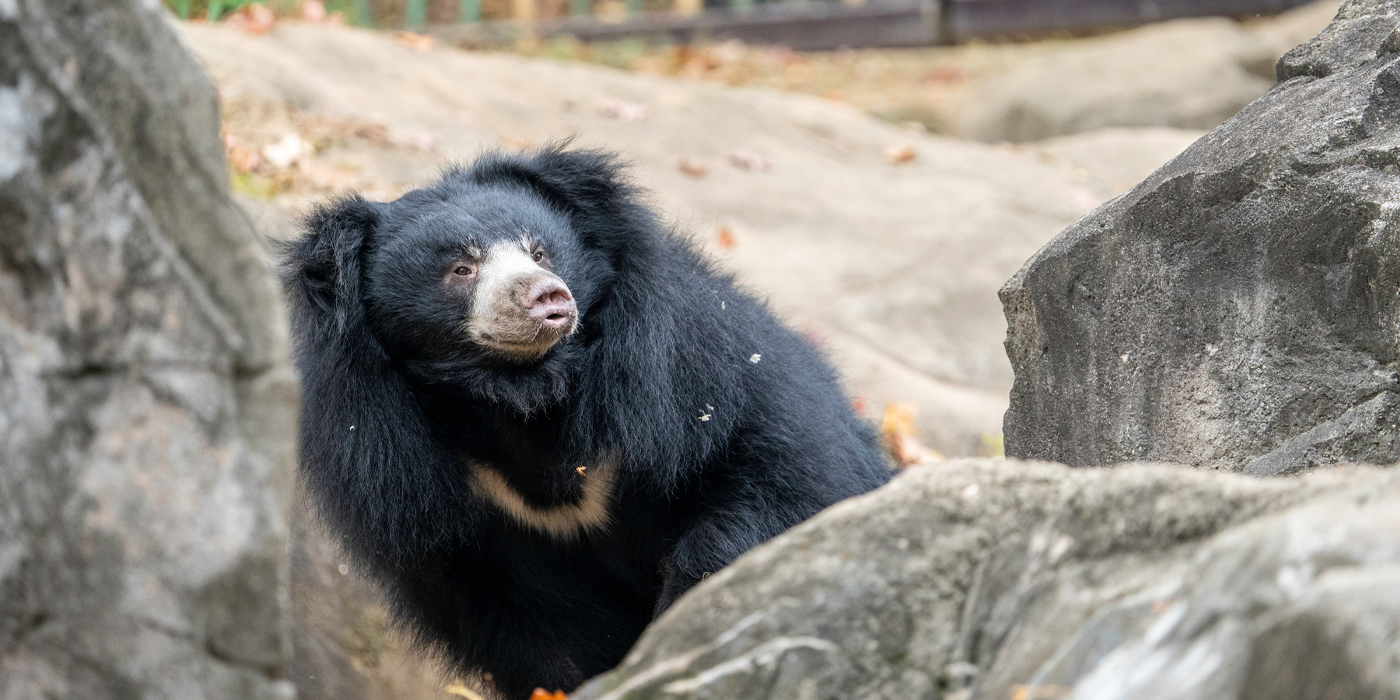
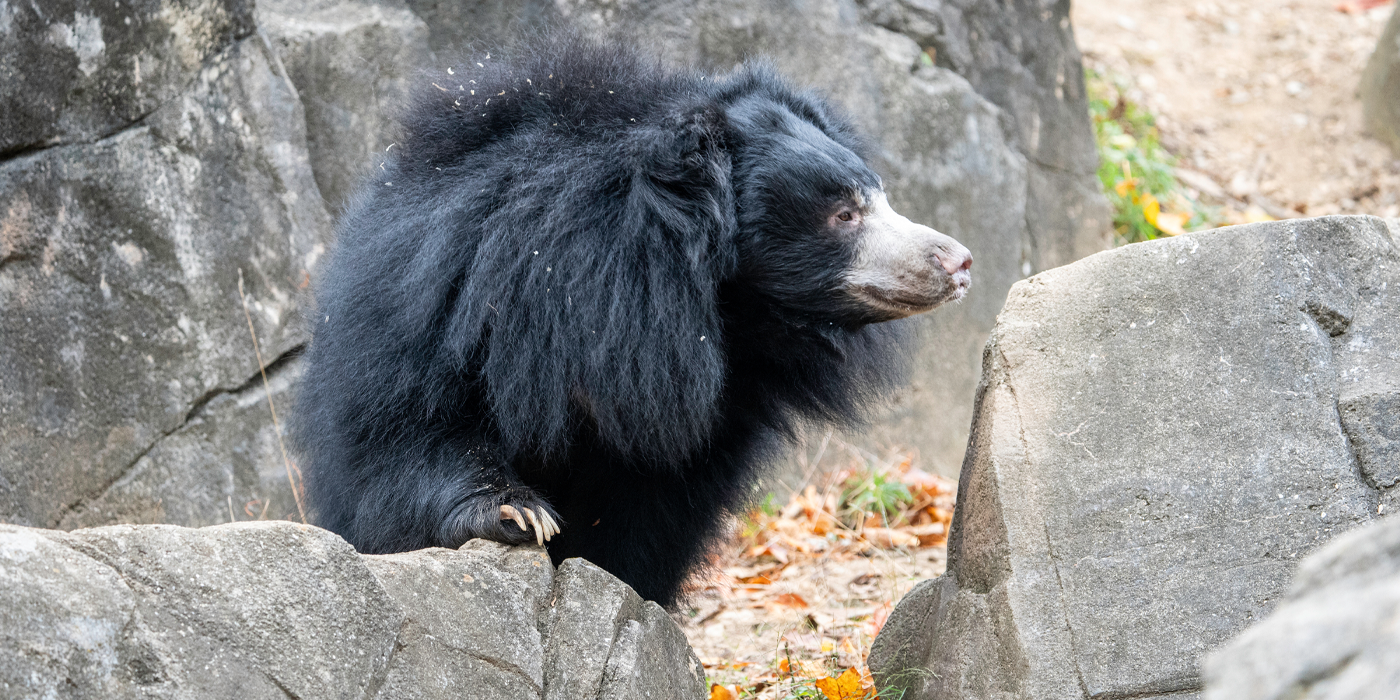
Vicki is a sloth bear, a forest-dwelling bear species native to South Asia. She arrived at the Zoo in the fall of 2023.
Let’s just say she’s here for the right reasons.
She’s sassy, smart and inquisitive. She’s got poufy hair with a part in the middle. Some of her favorite hobbies include playing with her enrichment toys and eating thousands of insects in one sitting.
Who’s the eligible bachelorette? It’s Vicki! And as you might have already guessed, this 10-year-old female sloth bear is the newest resident of the Zoo’s Asia Trail.

Vicki uses her strong paws to cradle a heavy ball in her indoor quarantine area.
Vicki, like other sloth bears, is intelligent, engaging and full of personality.
“It is a full-time job for animal keeper teams to provide opportunities for sloth bears to behave naturally in human care,” notes Michael Brown-Palsgrove, curator of the Asia Trail.
Before arriving at the Zoo this fall, Vicki had experienced much of her sloth bear life in the company of a mate: a male sloth bear named Rajani. But after Rajani passed away from cancer in 2019, Vicki’s keeper team at Capron Park Zoo in Massachusetts could tell she missed his companionship.
When the Asia Trail keeper team began planning for the arrival of a female sloth bear, they did so with the goal of allowing her to thrive in the companionship of members of her species—but first, they needed to help her feel at home.
Not Your Average Bear
Native to the dense forests of India, Sri Lanka and Nepal, sloth bears might be the most unique among the world’s eight species of bears. (To set the record straight: they’re bears, not sloths. However, their curved claws and shaggy fur apparently gave a sloth-like impression to the 18th century European biologist who formally named them.)
Even though they’re classified as carnivores, sloth bears are not meat eaters. They play a pivotal role in sustaining healthy forest ecosystems because the bulk of their diet is insects, like ants and termites—and lots of them. By some estimates, an adult can eat up to 500,000 insects per day.
If you had a myrmecophagous (insect-eating) diet, you would definitely want the adaptations that sloth bears have. Long, curved claws come in handy as you dig through dirt and open up termite mounds. Missing your top two front teeth would allow you to suck and blow air at rotting wood as you search for larvae. Having the ability to close each nostril individually would stop fleeing ants from crawling inside your nose. And of course, you would want two long, floppy lips, which would allow you to suck up tiny prey like the nozzle of a vacuum cleaner.
Outside of cub-rearing, sloth bears like Vicki live solitary lives in the wild. As is the case with many large carnivores, resource competition can lead to harmful encounters with other members of their species when times are tough.
But in zoos and wildlife facilities, sloth bears do not have to resort to physical conflict over who gets to eat at the termite mound. Keepers and researchers in the Association of Zoos and Aquariums (AZA) community have noticed cohabitating sloth bears are more than willing to share their space peacefully, and will often develop complex, long-lasting relationships with each other. It is a relatively new insight into sloth bear behavior, and it seems to be working out well for the bears already at the Smithsonian’s National Zoo.
'The Boys'
Before Vicki arrived in September, the Asia Trail already had two male sloth bears. “The boys”, as the Asia Trail keepers call them fondly, are 9-year-old Niko, who came to the Zoo in 2019 from Germany, and 5-year-old Deemak, who arrived in 2021 from San Diego Zoo. Keepers say they are curious, playful and goofy.
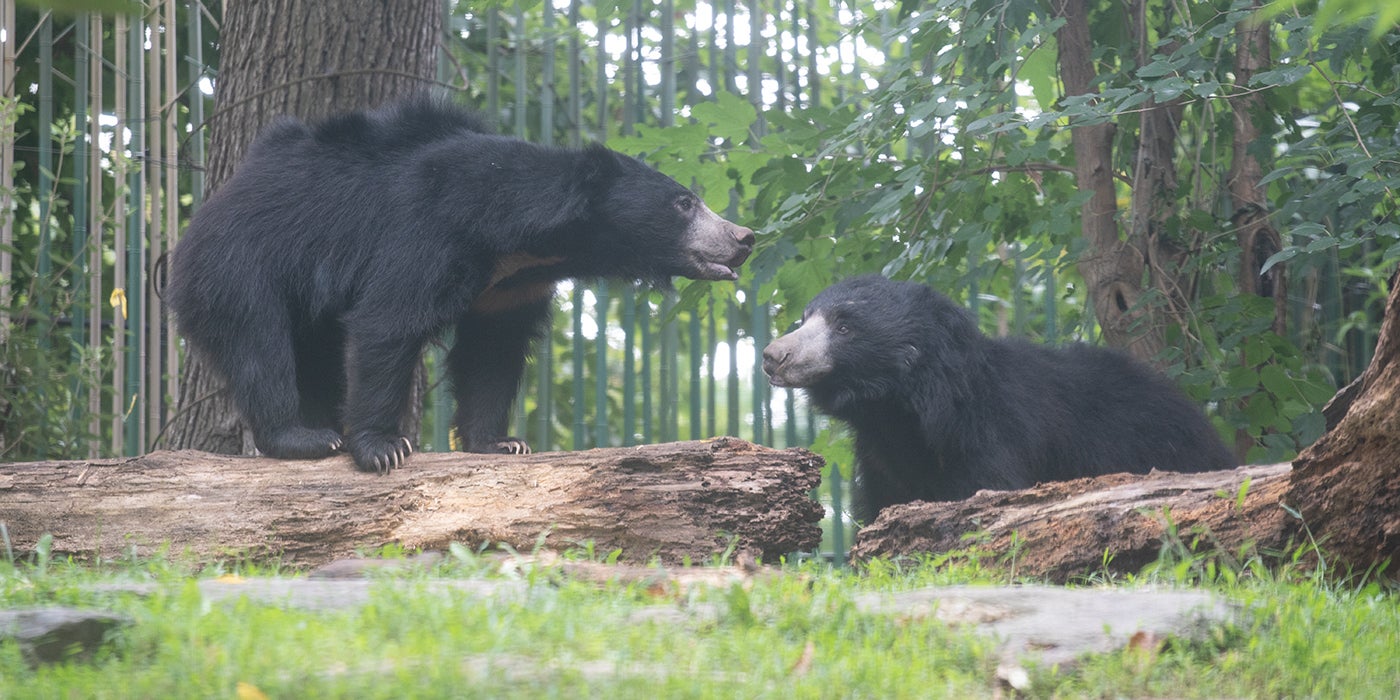
The Zoo's two male sloth bears, Niko (left) and Deemak (right), have an almost sibling-like relationship.
Moviegoers may recognize that Baloo from ‘The Jungle Book' is based on a sloth bear—and as Asia Trail keeper AJ Muheim points out, his good natured and resourceful personality fits Niko and Deemak perfectly. “Some of the things Baloo does in the movie, like skewering a piece of fruit on his claw like a kebab… that’s almost exactly how real sloth bears behave.”
Companionship is a valuable source of enrichment for Niko and Deemak, who have developed a relationship just like siblings. Asia Trail keeper Stacey Tabellario notes they love to play and wrestle: “I can’t count the number of times we have seen them playing and joked, ‘Wrestlemania 3000!’… They have great time, they sleep in a pile when it’s cold… [and on the rare occasions when they need to be separated], they immediately want to reunite.”
A Vulnerable Species
Once abundant in the wild, sloth bears have steadily lost ground over the last century. The species is listed as “vulnerable” by the International Union for Conservation of Nature due to deforestation, habitat destruction and fragmentation, hunting and capture. The total population of sloth bears is estimated to be about 20,000 individuals.
Alongside conservation organizations working to protect their native habitat, sloth bears populations in human care are carefully managed by the AZA’s Species Survival Plan (SSP). The goal is to sustain these animals through a multi-pronged approach centered around public education, in-situ habitat conservation and ex-situ population management. However, there are only about 36 sloth bears in the North American population managed by the AZA, so breeding pairs are essential.
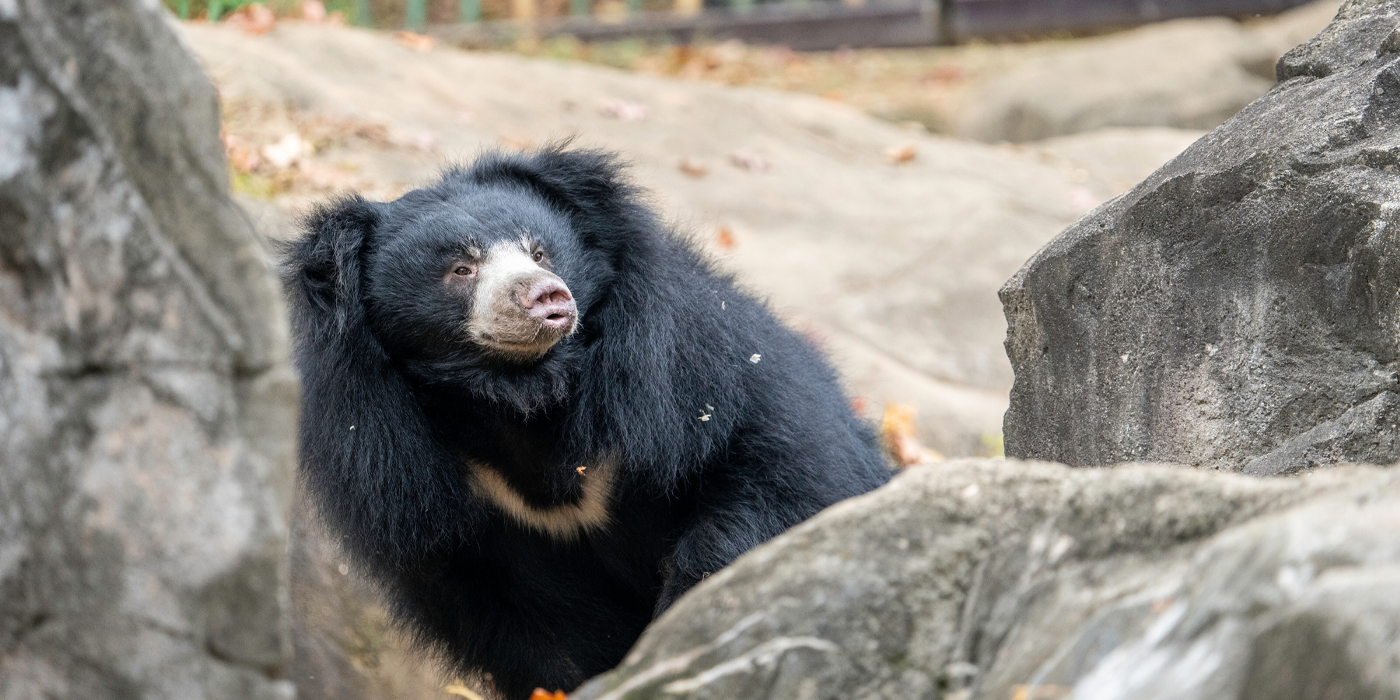
Vicki perches on a rock in her outdoor exhibit area.
A Special Delivery
In late September, Asia Trail keepers Tabellario and Muheim got to bond with Vicki as they brought her to the Zoo in the welcome wagon. Which, in this case, was a white Sprinter van with enough room in the back for a sloth bear-sized travel crate.
The trip was a little shaky at first. Vicki could not eat right away: veterinarian’s orders were to hold food for a few hours to help settle her stomach. Vicki became a little antsy.
But Tabellario and Muheim solved the problem with—what else? —a big bag of snacks, prepared by her keeper team at Capron Park. For the rest of the trip, she was calm.
“At one point, I checked behind me and she was hanging her claws on the side of her crate, looking out of the rear window and taking in the view… [one thing] that really got her attention was when we went through one of the tunnels [on I-95] and the LED lights blurred past as we drove and she was like, ‘whoooa,’” said Tabellario.
‘Do You Want to Be My Friend?’
Upon arrival, Vicki immediately captured the attention of Niko and Deemak. It is standard procedure for any animal arriving at a zoo to enter a quarantine period. For about 30 days, veterinarians, nutritionists and other animal care team members keep a close eye on the arriving animal in an off-exhibit area, making frequent checkups to ensure the newcomer is relaxed and ready to make their public debut.

Vicki plays with a heavy wooden enrichment object in her indoor quarantine area.
Although separated by lots of room and several mesh barriers, both male bears started vocalizing with gulp-grunts (which is sloth bear for, “I’m nice, I’m friendly, do you want to be my friend?”).
Vicki seemed interested as well.
To keep Vicki mentally and physically stimulated, keepers provided her with a variety of enrichment, including tree trunks, branches, bobbin toys and puzzle feeders. Capron Park keepers even passed along some tips about Vicki’s favorite toys. Things went smoothly, and after about a month, Vicki made it through quarantine with no issues.
Although she’s still getting used to her enclosures and exhibit yards, she has acclimated to the Asia Trail’s care routine and spends more time out in her yard each day. On warm days, visitors might get a glimpse of Vicki while she’s foraging for snacks, clambering over rocks or taking a nap in a sunbeam.
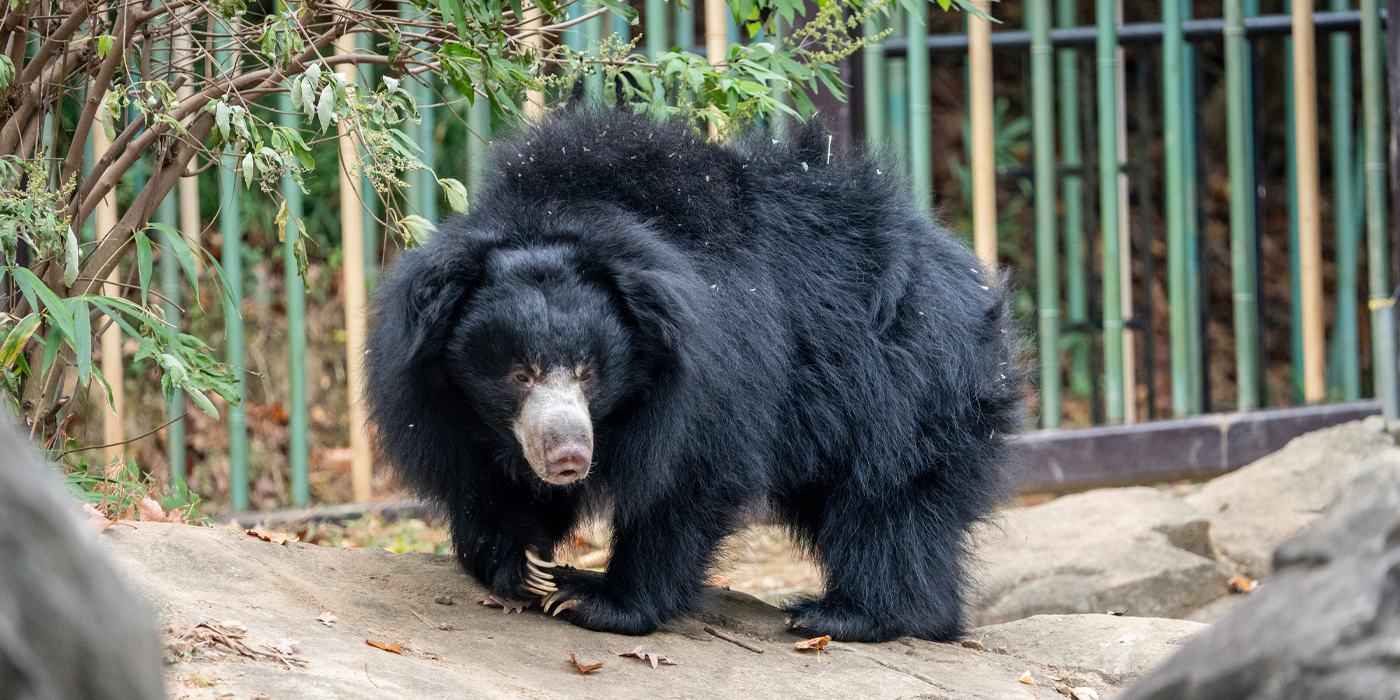
On warm days, Vicki, Niko and Deemak can be found outdoors on the Asia Trail.
What Does the Future Hold?
Introduction is a bit of a process for zoo animals. For sloth bears, they’ll need to see each other from far away, get used to each other’s smells, see each other up close with mesh between them and then touch introductions—all while being closely monitored by the keeper team.
Animal care team members look for behavioral indicators like head rubbing, gulp-grunting or bringing each other food and blankets. Once they’re confident each bear is getting along nicely, they’ll plan for a meeting without barriers.
As of early November, Vicki, Niko and Deemak made it through the process of touch introductions, where they get the opportunity to touch each other’s paws—and because they are sloth bears, lips.
Physical introductions, where the bears share space together, are next. If things continue to go well, Vicki and the other bears should be together in the exhibit yards soon.
The surest sign that she feels at home and with the other members of her species? Cubs.
“We hope for a breeding and birth, not just for Asia Trail but for the entire sloth bear population,” said Brown-Palsgrove.
Related Species:


